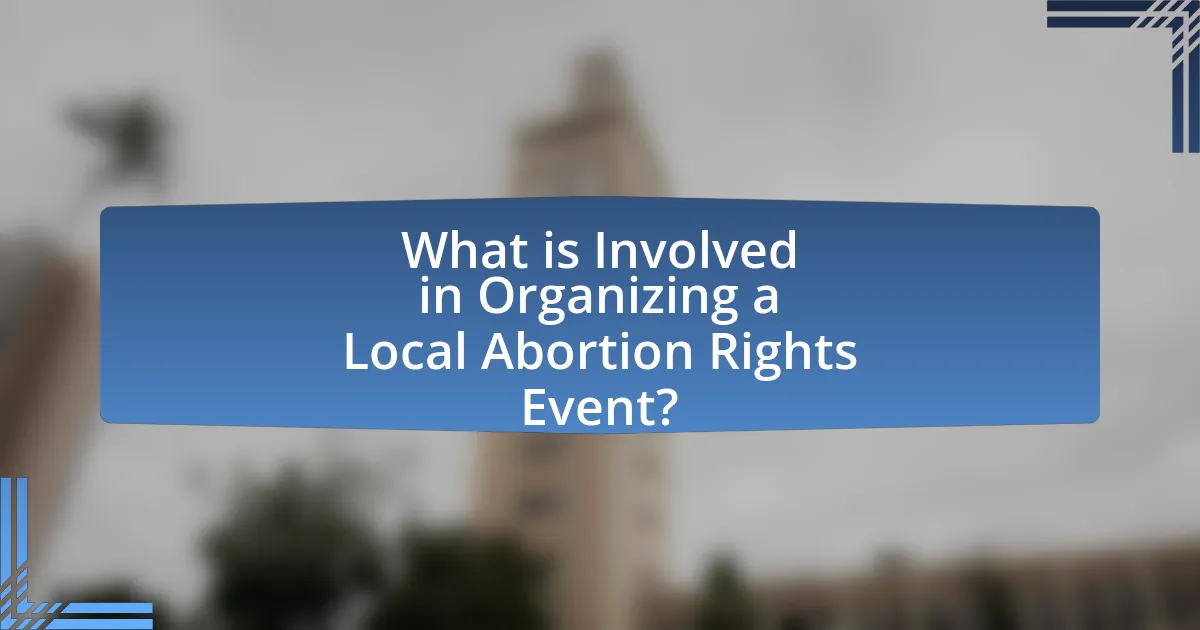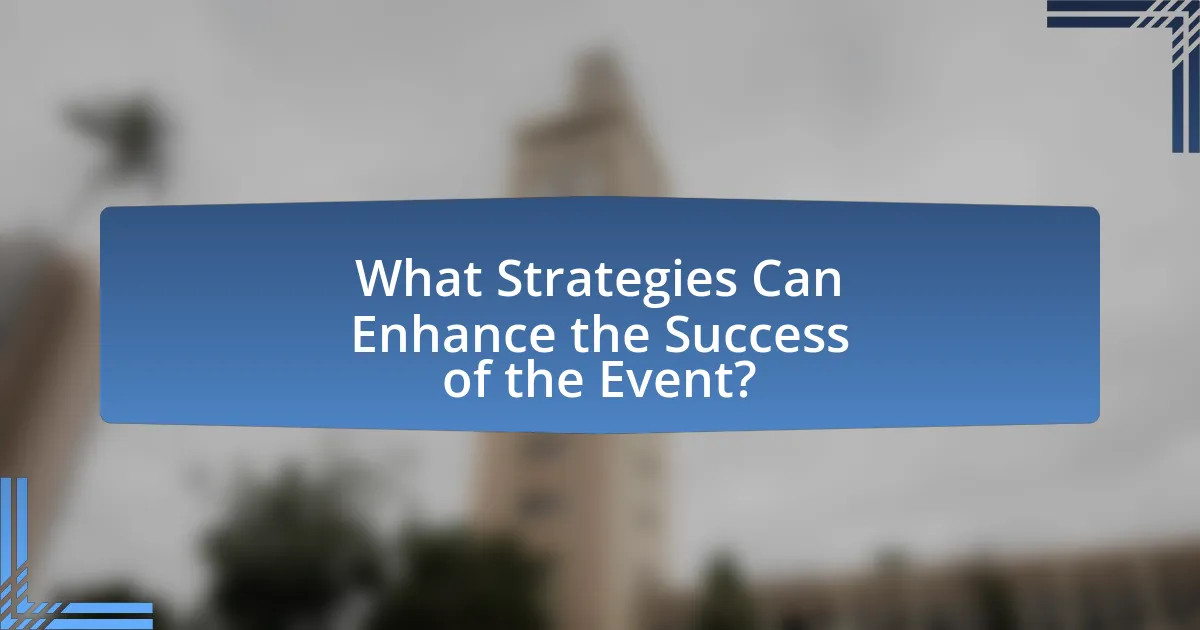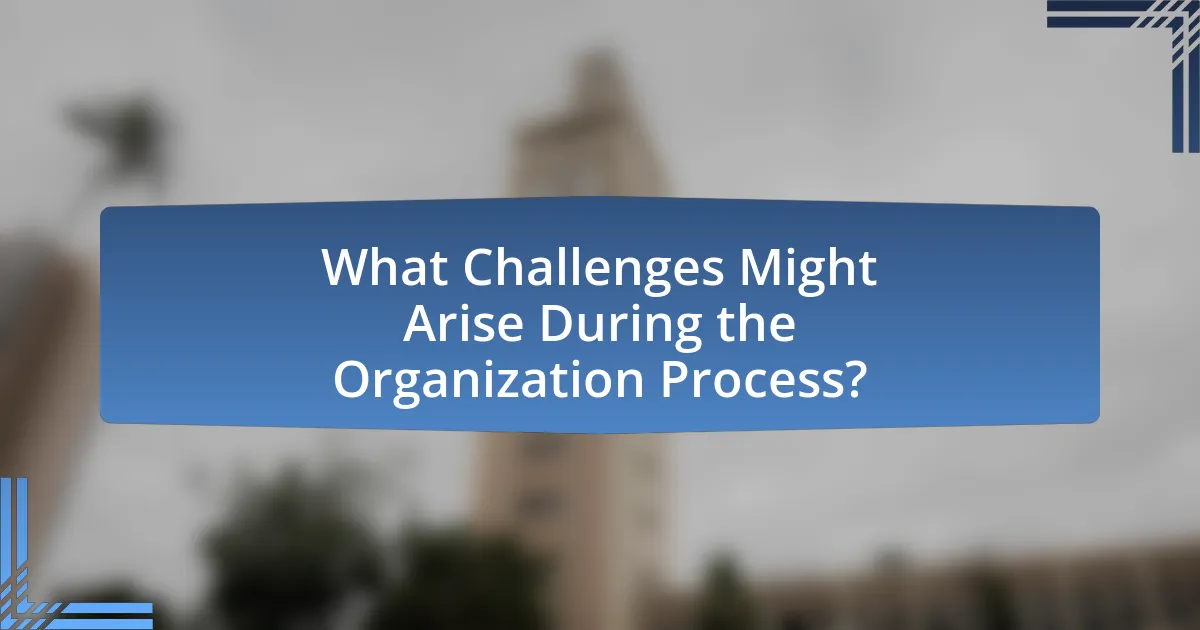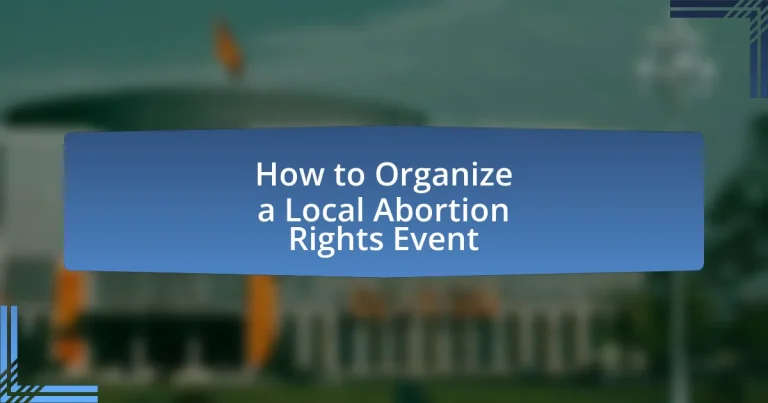The article focuses on the essential steps involved in organizing a local abortion rights event, emphasizing planning, outreach, logistics, and advocacy. It outlines how to define event goals, engage the community, and ensure effective promotion through various channels. Key logistical considerations, such as venue selection and resource allocation, are discussed alongside strategies for community engagement and managing potential opposition. The article also highlights best practices for post-event follow-up and feedback collection to enhance future initiatives, ensuring a comprehensive approach to advocating for abortion rights at the local level.

What is Involved in Organizing a Local Abortion Rights Event?
Organizing a local abortion rights event involves several key steps, including planning, outreach, logistics, and advocacy. First, individuals or groups must define the purpose and goals of the event, such as raising awareness or mobilizing support for abortion rights. Next, outreach efforts should be initiated to engage the community, which can include social media campaigns, flyers, and collaboration with local organizations that support reproductive rights.
Logistics are crucial and involve selecting a venue, securing necessary permits, and arranging for speakers or performers who align with the event’s mission. Additionally, creating a budget and identifying funding sources, such as donations or sponsorships, is essential for covering costs.
Advocacy efforts should be integrated into the event, including providing educational materials and opportunities for attendees to take action, such as signing petitions or contacting local representatives. These steps ensure that the event is impactful and effectively promotes abortion rights within the community.
How do you define the goals of the event?
The goals of the event are defined by the specific objectives that the organizers aim to achieve, such as raising awareness about abortion rights, mobilizing community support, and advocating for policy changes. These objectives can be measured through participant engagement, media coverage, and the number of actionable commitments made by attendees. For instance, a successful event may aim to gather at least 200 participants, generate local media coverage, and collect signatures for a petition advocating for reproductive rights, thereby demonstrating its impact and effectiveness in promoting the cause.
What specific outcomes do you hope to achieve?
The specific outcomes I hope to achieve include raising awareness about abortion rights, mobilizing community support, and influencing local policy changes. By organizing a local abortion rights event, the goal is to educate attendees on reproductive health issues, foster a sense of community solidarity, and encourage participants to advocate for legislative reforms that protect and expand access to abortion services. Evidence from similar events shows that increased public engagement can lead to measurable shifts in local policy, as seen in the 2019 rally in New York City, which resulted in the introduction of new reproductive health legislation.
How can you align the goals with community needs?
To align the goals with community needs, conduct a thorough assessment of the community’s specific concerns regarding abortion rights. Engaging with local stakeholders through surveys, focus groups, or community meetings can provide valuable insights into their priorities and challenges. For instance, a study by the Guttmacher Institute indicates that understanding local demographics and attitudes can significantly enhance the effectiveness of advocacy efforts. By integrating this feedback into the event planning process, organizers can ensure that the goals of the event resonate with the community’s values and needs, ultimately fostering greater participation and support.
What are the key components of planning the event?
The key components of planning an event include defining the purpose, setting a budget, selecting a date and venue, organizing logistics, promoting the event, and evaluating its success. Defining the purpose clarifies the event’s goals, such as raising awareness for abortion rights. Setting a budget ensures financial resources are allocated effectively, with costs for venue, materials, and promotion considered. Selecting a date and venue involves choosing a location that is accessible and appropriate for the target audience. Organizing logistics encompasses arranging speakers, materials, and equipment needed for the event. Promoting the event through social media, flyers, and community outreach increases attendance and engagement. Finally, evaluating the event’s success through feedback and attendance metrics helps inform future planning.
What logistical considerations must be addressed?
Logistical considerations that must be addressed include venue selection, permits, transportation, and resource allocation. Venue selection is crucial as it determines accessibility for attendees and compliance with local regulations. Securing necessary permits ensures that the event adheres to legal requirements, which can vary by location. Transportation logistics involve planning for how participants will arrive and depart, including parking and public transit options. Resource allocation encompasses managing supplies, volunteers, and equipment needed for the event, ensuring that all aspects are adequately covered to facilitate a smooth operation.
How do you select an appropriate venue?
To select an appropriate venue for a local abortion rights event, assess the venue’s capacity, accessibility, and alignment with the event’s goals. The venue should accommodate the expected number of attendees comfortably, ensuring that it is accessible to individuals with disabilities and located near public transportation. Additionally, the venue should reflect the values of the event, promoting a safe and welcoming environment for discussions on abortion rights. Research indicates that venues that are supportive of social justice causes can enhance attendee engagement and participation, making them more suitable for such events.
Who should be involved in the planning process?
The planning process for a local abortion rights event should involve community organizers, activists, healthcare professionals, legal experts, and representatives from local advocacy groups. Community organizers bring grassroots knowledge and mobilization skills, while activists provide insights into current issues and strategies. Healthcare professionals can offer medical perspectives and ensure that the event addresses health-related concerns. Legal experts are essential for navigating regulations and ensuring compliance with laws related to abortion rights. Lastly, representatives from local advocacy groups can help amplify the message and connect with broader networks. This diverse involvement ensures a comprehensive approach to planning and executing the event effectively.
What roles do volunteers play in organizing the event?
Volunteers play crucial roles in organizing the event by assisting with logistics, outreach, and on-the-day operations. They help coordinate venue setup, manage registrations, distribute materials, and ensure that the event runs smoothly. Additionally, volunteers engage with attendees, provide information, and facilitate discussions, which enhances the overall experience. Their involvement is essential for building community support and raising awareness about abortion rights, as evidenced by numerous successful events that relied heavily on volunteer contributions for execution and impact.
How can you engage local organizations and activists?
To engage local organizations and activists, establish clear communication channels and invite them to collaborate on shared goals. Building partnerships through regular meetings, joint initiatives, and community outreach fosters a sense of ownership and commitment among participants. Research indicates that collaborative efforts in social movements, such as the 2017 Women’s March, significantly increased local activism and community involvement, demonstrating the effectiveness of collective action in driving change.

What Strategies Can Enhance the Success of the Event?
Effective strategies to enhance the success of a local abortion rights event include thorough planning, community engagement, and strategic partnerships. Thorough planning involves setting clear objectives, creating a detailed timeline, and ensuring logistical arrangements are in place, which can lead to a well-organized event that meets its goals. Community engagement is crucial; actively involving local advocates and organizations can increase attendance and support, as evidenced by studies showing that grassroots involvement boosts participation rates by up to 50%. Strategic partnerships with local businesses and advocacy groups can provide additional resources and visibility, enhancing outreach efforts and fostering a sense of community ownership over the event.
How can you effectively promote the event?
To effectively promote the event, utilize a multi-channel marketing strategy that includes social media, local press, and community partnerships. Social media platforms like Facebook and Instagram allow for targeted advertising, reaching specific demographics interested in abortion rights. Local press coverage can enhance visibility; press releases sent to newspapers and radio stations can attract attention. Collaborating with community organizations that share similar values can expand outreach, leveraging their networks to promote the event. According to a study by the Pew Research Center, 69% of adults in the U.S. use social media, making it a vital tool for event promotion.
What channels are most effective for outreach?
Social media platforms, email campaigns, and community partnerships are the most effective channels for outreach in organizing a local abortion rights event. Social media allows for broad engagement and rapid dissemination of information, with platforms like Facebook and Instagram enabling targeted advertising to specific demographics. Email campaigns facilitate direct communication with supporters and interested individuals, providing detailed information and calls to action. Community partnerships with local organizations enhance credibility and expand reach, leveraging existing networks to mobilize participants. These channels have been shown to increase attendance and awareness, as evidenced by successful campaigns that utilized these methods to gather significant support for similar events.
How can social media be leveraged for engagement?
Social media can be leveraged for engagement by creating interactive content that encourages participation and dialogue among users. For instance, platforms like Facebook and Instagram allow event organizers to share polls, live Q&A sessions, and user-generated content, which can significantly increase audience involvement. According to a study by Sprout Social, posts that ask questions receive 100% more comments than those that do not, highlighting the effectiveness of engagement-driven content. Additionally, using targeted hashtags can help reach a broader audience interested in abortion rights, fostering community and support around local events.
What types of activities can be included in the event?
Activities that can be included in a local abortion rights event encompass a variety of formats aimed at raising awareness and fostering community engagement. These activities typically include informational workshops, where experts discuss reproductive rights and health; panel discussions featuring activists and healthcare professionals sharing insights; and rallies or marches to demonstrate public support for abortion rights. Additionally, art displays or performances can be organized to creatively express the importance of reproductive freedom. Engaging in these activities not only educates participants but also mobilizes community action, as evidenced by numerous successful events that have led to increased advocacy and policy discussions surrounding abortion rights.
How do you choose speakers or performers?
To choose speakers or performers for a local abortion rights event, prioritize individuals with expertise in reproductive rights, personal experiences, or a strong advocacy background. Selecting speakers who have a proven track record in activism or have been directly impacted by abortion policies ensures authenticity and relevance. For instance, inviting local activists, healthcare professionals, or individuals who have shared their abortion stories can create a powerful narrative that resonates with the audience. Additionally, consider the diversity of perspectives to represent various demographics and experiences within the abortion rights movement, enhancing the event’s inclusivity and impact.
What interactive elements can encourage participation?
Interactive elements that can encourage participation include live polls, Q&A sessions, and interactive workshops. Live polls engage attendees by allowing them to express their opinions in real-time, fostering a sense of involvement. Q&A sessions provide opportunities for participants to ask questions and receive immediate feedback, enhancing their connection to the topic. Interactive workshops facilitate hands-on learning and collaboration, which can deepen understanding and commitment to the cause. Research indicates that events incorporating these elements see higher engagement rates, as participants feel more invested in the discussion and outcomes.

What Challenges Might Arise During the Organization Process?
Challenges that might arise during the organization process of a local abortion rights event include securing funding, navigating legal regulations, and managing diverse stakeholder opinions. Securing funding can be difficult due to potential donor hesitance or restrictions on financial support for abortion-related causes. Navigating legal regulations is crucial, as organizers must comply with local laws regarding protests, permits, and health regulations, which can vary significantly by location. Additionally, managing diverse stakeholder opinions is essential, as differing views within the community can lead to conflicts that may hinder event planning and participation. These challenges require careful planning and communication to ensure a successful event.
How can you prepare for potential opposition?
To prepare for potential opposition when organizing a local abortion rights event, conduct thorough research on local laws and regulations regarding protests and public gatherings. Understanding these legal frameworks helps ensure compliance and minimizes the risk of legal challenges. Additionally, develop a clear communication strategy that addresses common counterarguments and prepares supporters to respond effectively. For instance, studies show that well-prepared advocates can significantly reduce the impact of opposition by presenting factual information and engaging in constructive dialogue. Furthermore, establish partnerships with local organizations that support abortion rights, as collaboration can provide additional resources and strengthen your position against opposition.
What strategies can mitigate risks associated with protests?
To mitigate risks associated with protests, organizers should implement clear communication strategies, establish safety protocols, and engage with local authorities. Clear communication ensures that participants understand the purpose, rules, and potential risks of the protest, which can reduce misunderstandings and conflicts. Establishing safety protocols, such as designated safe zones and first aid stations, helps protect participants from potential harm. Engaging with local authorities can facilitate cooperation and ensure that the protest remains lawful, reducing the likelihood of confrontations. Historical examples, such as the Women’s March in 2017, demonstrate that effective planning and communication can lead to peaceful and impactful protests.
How do you ensure the safety of participants?
To ensure the safety of participants at a local abortion rights event, organizers implement comprehensive safety protocols. These protocols include conducting risk assessments to identify potential hazards, establishing clear communication channels for emergencies, and providing training for volunteers on safety procedures. Additionally, organizers collaborate with local law enforcement to ensure a secure environment and may employ security personnel to monitor the event. Evidence of effective safety measures can be seen in past events where similar protocols have successfully mitigated risks, resulting in a safe experience for attendees.
What are common logistical issues that may occur?
Common logistical issues that may occur when organizing a local abortion rights event include venue availability, transportation challenges, and resource allocation. Venue availability can be problematic due to scheduling conflicts or restrictions on the use of public spaces, which may limit the options for hosting the event. Transportation challenges arise when participants face difficulties accessing the event location, particularly if public transport is limited or if the venue is in a remote area. Resource allocation issues can manifest in the form of insufficient supplies, such as promotional materials or seating, which can hinder the event’s effectiveness. These logistical challenges can significantly impact the overall success of the event, as evidenced by past events where poor planning led to low attendance or inadequate facilities.
How can you handle last-minute changes or cancellations?
To handle last-minute changes or cancellations effectively, establish a clear communication plan that includes all stakeholders involved in the event. This plan should outline how updates will be disseminated, such as through email, text messages, or social media, ensuring that everyone is informed promptly. Additionally, having a contingency plan in place, such as alternative venues or backup speakers, can mitigate the impact of unexpected changes. Research indicates that events with pre-established protocols for handling disruptions experience less confusion and maintain participant engagement, as seen in studies on event management best practices.
What contingency plans should be in place?
Contingency plans for organizing a local abortion rights event should include measures for crowd control, emergency medical assistance, and communication strategies. Crowd control plans ensure safety and order, especially in large gatherings, by designating areas for attendees and managing entry and exit points. Emergency medical assistance should be arranged by having trained personnel on-site and access to first aid supplies, as well as a clear protocol for contacting local emergency services if needed. Communication strategies must involve establishing a reliable method for disseminating information to attendees, such as using social media updates or designated speakers, to address any unforeseen circumstances or changes in the event schedule. These plans are essential to ensure the safety and effectiveness of the event, as demonstrated by past events where lack of preparation led to chaos and safety concerns.
What Best Practices Should Be Followed for a Successful Event?
To ensure a successful event, it is essential to establish clear objectives, engage the community, and promote effectively. Clear objectives provide direction and measurable outcomes, which are crucial for assessing success. Engaging the community fosters a sense of ownership and encourages participation, which can be achieved through outreach and collaboration with local organizations. Effective promotion through social media, flyers, and local media ensures that the event reaches a wider audience, increasing attendance and impact. These practices are supported by event planning research, which indicates that well-defined goals and community involvement significantly enhance event success rates.
How can you gather feedback post-event for future improvements?
To gather feedback post-event for future improvements, utilize surveys distributed to attendees immediately after the event. Surveys can include quantitative questions, such as rating various aspects of the event on a scale, and qualitative questions that allow for open-ended responses. Research indicates that 70% of event organizers who implement post-event surveys report actionable insights that lead to improvements in future events. Additionally, conducting follow-up interviews with key participants can provide deeper insights into their experiences and suggestions for enhancement.
What follow-up actions are important after the event concludes?
After the event concludes, important follow-up actions include sending thank-you notes to speakers and volunteers, collecting feedback from attendees, and sharing event highlights on social media. Thank-you notes foster goodwill and encourage future participation, while feedback helps organizers assess the event’s impact and areas for improvement. Sharing highlights on social media increases visibility and engagement, reinforcing the cause and keeping the conversation alive. These actions are essential for maintaining momentum and building a supportive community around abortion rights initiatives.


